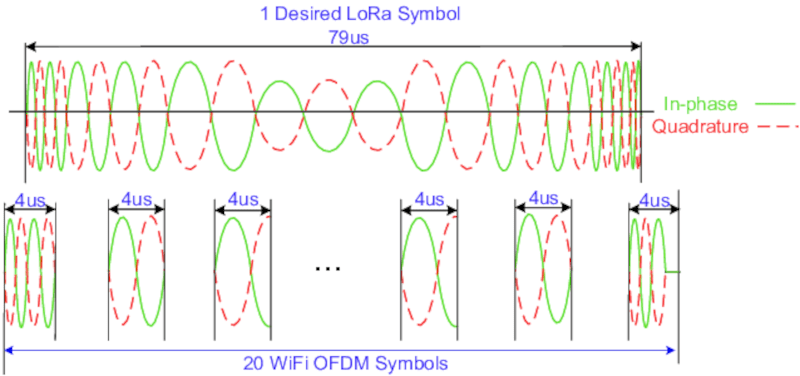What do you get when you cross WiFi and LoRa? Researchers in China have been doing this, and they call the result WiLo. They claim to get reliable connections over about half a kilometer. Typical WiFi runs 40 to 60 meters, barring any Pringle’s cans or other exotic tricks.
According to [Michelle Hampson] writing in IEEE Spectrum, the researchers manipulated Wi-Fi’s OFDM multiplexing to emulate LoRa’s chirp-spreading signal. The advantage is that existing WiFi hardware can use the protocol to increase range.
While LoRa is known for being economical with power, this might not be the case with repurposed WiFi devices. The researchers plan to explore ways to make WiLo more energy efficient. You can read the research paper if you want to dig into the details.
There are also some efficiency issues. The WiFi header, trailer, and preamble can’t contribute to the fake LoRa signal, so they are ignored by the LoRa receiver. We aren’t sure, but we wondered if some or most WiFi cards are now based on SDR technology anyway. If you had the internal details of the SDR, it seems like you could simply reprogram the entire unit to do whatever protocol you wanted. Still, those details are probably hard to obtain.
LoRa seems prime for hacking. Of course, 500 meters is just the tip of the iceberg.
















Even if some WiFi devices are based on SDR, the firmware is a notorious closed-off blob. Reverse-engineering this might be possible, but it’s unlikely to be practical.
What about all the routers running OpenWRT?
The problem lies in the firmware of the “Wi-Fi Chipset”, not the firmware of the main processor.
There are some attempts to crack this (ex: https://github.com/seemoo-lab/nexmon ), but most of them are pretty limited and/or difficult to use.
Looks like a solution looking for a problem.
Since there are 2.4GHz LoRa devices available, I wonder what would be the use for this? Clearly, if you need Chip Spread modulation, buy a LoRa device and it’ll work, at a reasonable bandwidth and range. Using a WIFI device to emulate LoRa (and spending time reverse engineering the closed firmware) is like using a Ferrari to emulate a bike. Sure, you can probably improve the MPG of the Ferrari by going 10x slower or more, but it’s clearly not the tool to do so.
For starters, talking to a LoRa device with something that doesn’t have the hardware, but does have wifi? (e.g. a laptop or smartphone)
It’s not “use a wifi device to speak LoRA to other LoRA devices”, it’s “repurpose wifi hardware to talk WiLo to other WiLo devices at longer range”. You could have a device that runs a local wifi network but also has longer WiLo links without needing to have multiple RF hardware blocks on each end.
Isn’t Wi-Fi something that would absolutely not be implemented as an SDR? Technologically challenging with massive throughput and production volumes are massive, so an application specific implementation is viable
Complexity makes it easier to just drop down a core to offload the work to and do the implementation in software.
No, it has already been implemented in SDR https://github.com/open-sdr/openwifi
Of course it can be done, but in that repo the example boards are 300-3000 $, while a simple WiFi IC is ~1 $ in bulk
WiMax was on SDR ~20 years ago.
2.4 GHz seems a poor choice for long distance communications, as it is so strongly affected by whatever is in the way. I think that is why LoRa usually uses lower frequency bands.
It depends. Yes, the shorter wavelength limits range, but at the same time, it takes less time to transmit a packet, so it’s unlikely to be jammed/disturbed. In the end, LoRa 2.4GHz works quite well for mid-range communication (something like 600m to few km) with a bandwidth of… 250kb/s or so, IIRC. Also, you don’t have the duty cycle constraints on 2.4GHz unlike 868 or 915MHz, so you could maintain this bandwidth for longer if required.
Just let go of wifi and 2.4Ghz
Wifi at 2.4GHz is high bandwidth, LoRa has long range but low bandwidth–good for IoT style messaging but not for general networking. We need both, and this is a cool idea to make them interoperate.
“Typical WiFi runs 40 to 60 meters, barring any Pringle’s cans or other exotic tricks.”
Ehhhh that depends? An old picostation or one of these can beat that, while still being omnidirectional. https://www.netwifiworks.com/UniFi-AP-AC-Mesh.asp The pringles can stuff is not really that smart IMO, when you can just replace the antennas instead of adding imperfect reflectors. (adjust tx power as legally required) And for actual directional stuff, if you have LOS you can go miles. Typical Lora benefits quite a bit from the lower frequencies, in order to get a little nLOS or NLOS, where 2.4 would probably run out of link budget too soon. That said, still a very neat hack I’ll have to dig into.
The problem with reprogramming the wifi radio is that every single wifi radio made in the last decade has a separate core running opaque firmware in control of the radio. Often an 8051, or perhaps an arm core in more recent adaptors. The host driver just chats with it by exchanging string-named variables. Reverse engineering efforts are far, far, far behind.
Frequency ability to get through NLOS… tree’s, partial obstructions, allow for 1 knife edge in the link budget would seem important. https://spectrum.ieee.org/wi-fi-halow at 900 MHz seems to be the compromise frequency and standard (ratified in 2017), including allowing clients to go to sleep for extended periods, but uptake has fizzled. Some wireless security camera systems have implemented WiFi-HaLow to increase the link range to distant camera’s, often solar powered.
A proper directional antenna is not an “exotic trick”…